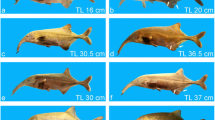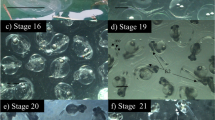Synopsis
No clear sexual dimorphism occurs in Pollimyrus isidori. Females usually grew slightly larger than males. The anal-fin reflex, however, makes it easy to discriminate between males and females. Spawning took place during the first six hours of the dark phase, in the territory of the male. During each spawning act 2–4 eggs were laid. The male put the eggs into a well-hidden nest previously constructed from plant material. The eggs, free embryos, and larvae of several spawnings were guarded by the male for several weeks. The females laid on average 120 eggs per fractional spawning. The eggs were 2 mm in diameter, not adhesive and very yolky. There was a relationship between pH and viability (% embryos hatched). Hatching occurred on the third day after spawning. The respiratory network of segmental origin in the median fin fold was well developed in the free embryos. Transition to exogenous feeding occurred on day 14. The larval period ended when the fish were 15 mm long and 40–50 days old. First gonadal recrudescence occurred at a total length of 6 cm (about 200 days old). The environmental factors decreasing conductivity and pH, increasing water level, and imitation of rain led to gonadal recrudescence, but pH did not act as a cue. Recrudescence was triggered by a decrease of conductivity, but absolute values or ionic composition of the water were not important. Maturation was completed after about fifty days. Mature and spawning fish no longer required any variation of these environmental factors to maintain mature gonads. A steady and considerable increase in conductivity led to gonadal regression. The fish did not show postbreeding refractoriness.
Similar content being viewed by others
References cited
Albaret, J.-J. 1982. Réproduction et fécondité des poissons d'eau douce de Cte d'Ivoire. Rev. Hydrobiol. Trop. 15: 347–371.
Ang-Lek, S. 1979. Biologie des pétits Mormyridae du Bassin tchadien. These de spécialité. Univ. Paul Sabatier, Toulouse. 117 pp.
Arndt, E.A. 1956. Histologische und histochemische Untersuchungen über die Oogenese und bipolare Differenzierung von Süβwasser-Teleosteern. Protoplasma 47: 1–36.
Atz, J.W. 1957. The relation of the pituitary to reproduction in fishes. pp. 178–270. In: G.E. Pickford & J.W. Atz (ed.) The Physiology of the Pituitary Gland of Fishes, New York Zoological Society, New York.
Balon, E.K. 1975. Terminology of intervals in fish development. J. Fish. Res. Board Can. 32: 1663–1670.
Balon, E.K. 1985a. About processes which cause the evolution of guilds and species. pp. 73–82. In: Early Life Histories of Fishes, Dr W. Junk Publishers, Dordrecht.
Balon, E.K. 1985b. Additions and amendments to the classification of reproductive styles in fishes. pp. 59–72. In: Early Life Histories of Fishes, Dr W. Junk Publishers. Dordrecht.
Benech, V. & J. Quensière. 1985a. Strategies de réproduction des poissons du Tchad en riode de ‘Tchad Normal’ (1966–1971). Rev. Hydrobiol. Trop. 18 (in press).
Benech, V. & J. Quensière. 1985b. Variations du milieu et réproduction de certains poissons du lac Tchad. Réunion Ann. Soc. Franc. Ichtyol. (in press).
Birkholz, J. 1969. Zufällige Nachzucht bei Petrocephalus bovei. Das Aquarium 3: 201–203.
Birkholz, J. 1970. Nachwuchs bei Petrocephalus bovei. Das Aquarium 4: 340–342.
Blache, J. 1964. Les poissons du bassin du Tchad et du bassin adjacent du Mayo Kebbi. ORSTOM, Paris. 483 pp.
Crawford, J.D., M.M. Hagedorn & C.D. Hopkins. 1985. Acoustic song in an electric fish. Neurosc. Abstr. 11: 270.
Daget, J. 1958. Alevins de Mormyrus rume. Bull. Soc. Zool. France 83: 200–204.
Denizot, J.P., F. Kirschbaum, G.W.M. Westby & S. Tsuji. 1978. The larval electric organ of the weakly electric fish Pollimyrus (Marcusenius) isidori (Mormyridae. Teleostei). J. Neurocytol. 7: 165–181.
Denizot, J.P., F. Kirschbaum. G.W.M. Westby & S. Tsuji. 1982. On the development of the adult electric organ in the mormyrid fish Pollimyrus isidori (with special focus on the innervation). J. Neurocytol. 11: 913–934.
Ellis, M.M. 1913. The gymnotid eels of tropical America. Mem. Carnegie Mus. 6: 109–204.
Geisler, R. & S.R. Annibal. 1984. Ökologie des Cardinal-Tetra Paracheirodon axelrodi (Pisces, Characoidea) im Stromgebiet des Rio Negro/Brasilien sowie zuchrelevante Faktoren. Amazoniana 9: 53–86.
Gerking, S.D. 1980. Fish reproduction and stress. pp. 569–587. In: M.A. Ali (ed.) Environmental Physiology of Fishes, Plenum Press, New York.
Gosse, J.P. 1984. Mormyridae. pp. 63–122. In: J. Daget, J.P. Gosse & D.F.E. Thys van den Audenaerde (ed.) Check list of the Freshwater Fishes of Africa, Volume 1, ORSTOM. Paris, MRAC, Tervuren.
Grier, J.H. 1981. Cellular organization of the testis and spermatogenesis in fishes. Amer. Zool. 21: 345–357.
Heymer, A. & W. Harder. 1975. Erstes Auftreten der elektrischen Entladungen bei einem jungen Mormyriden. Naturwiss. 62: 489.
Hopkins, C.D. 1972. Patterns of electric communication among gymnotid fish. Doctoral Dissertation, The Rockefeller University, New York. 190 pp.
Iles, R.B. 1960. External sexual differences and their significance in Mormyrus kannume (Forsk»l 1775). Nature 188: 516.
Johnels, A.G. 1954. Notes on fishes from the Gambia river. Ark. Zool. 6: 327–411.
Kirschbaum, F. 1975. Evironmental factors control the periodical reroduction of tropical electric fish. Experientia 31: 1159–1160.
Kirschbaum, F. 1977. Electric organ ontogeny. Distinct larval organ precedes the adult organ in weakly electric fish. Naturwiss. 64: 387–388.
Kirschbaum, F. 1979. Reproduction of the weakly electric fish Eigenmannia virescens (Rhamphichthyidae Teleostei) in captivity. I. Control of gonadal recrudescence and regression by environmental factors. Behav. Ecol. Sociobiol. 4: 331–335.
Kirschbaum, F. 1981. Ontogeny of both larval electric organ and electromotoneurones in Pollimyrus isidori (Mormyridae Teleostei). pp. 129–157. In: T. Szabo & G. Czen (ed.) Sensory Physiology of Aquatic Lower Vertebrates, Adv. Physiol. Sci. 31, Pergamon Press, Budapest.
Kirschbaum, F. 1982. Reproduction of the mormyrid Pollimyrus isidori in captivity. Abstracts. 4th Congress of European Ichthyologists, Hamburg 149.
Kirschbaum, F. 1983. Myogenic electric organ precedes the neurogenic organ in apteronotid fish. Naturwiss. 70: 205–207.
Kirschbaum, F. 1984. Reproduction of weakly electric teleosts: just another example of convergent development? Env. Biol. Fish. 10: 3–14.
Kirschbaum, F. & J.P. Denizot. 1975. Sur la différenciation des électrorécepteurs chez Marcusenius sp. (Mormyridés) et Eigenmannia virescens (Gymnotidés), poissons électriques á faible décharge. C.R. Acad. Sci. (Paris) 281: 419–422.
Kirschbaum, F. & U. Leiendecker. 1985. Exogene Faktoren als Auslöser von Gonadenreifung and -rückbildung bei dem tropischen Regenwaldfisch Kryptopterus bicirrhis (Siluridae, Teleostei). Verh. Dtsch. Zool. Ges. 78: 251.
Kirschbaum, F. & G.W.M. Westby. 1975. Development of the electric discharge in mormyrid and gymnotid fish Marcusenius sp. and Eigenmannia virescens). Experientia 31: 1290–1293.
Lowe-McConnell, R.H. 1975. Fish communities in tropical freshwater. Longman, London. 337 pp.
Mattei, X., C. Mattei, C. Reitzer & J.L. Chevalier 1972. Ultrastructure des spermatozoides aflagellés des Mormyres (Poissons Teleosteens). J. Microscopie 15: 67–78.
Nawar, G. 1960a. Observation on breeding of six members of the Nile Mormyridae. Ann. Mag. Nat. Hist. 2: 493–504.
Nawar, G. 1960b. A study on the fecundity of the Nile Mormyrid Hyperopisus bébé Lacépède. Ann. Mag. Nat. Hist. 2: 603–606.
Okedi, J. 1969. Observation on the breeding and growth of certain mormyrid fishes of the Lake Victoria basin. Rev. Zool. Bot. Afr. 79: 34–64.
Olatunde, A.A. & C.C. Moneke. 1985. The food habits of four mormyrid species in Zaria, Nigeria. Arch. Hydrobiol. 102: 503–517.
Richards, P.W. 1952. The tropical rain forest. Cambridge University Press, Cambridge. 450 pp.
Roberts,T.R. 1972. Ecology of fishes in the Amazon and Congo basins. Bull. Mus. Comp. Zool. 143: 117–147.
Schwassmann, H.O. 1976. Ecology and taxonomic status of the different geographic populations of Gymnorhamphichthvs hypostomus Ellis (Pisces, Cypriniformes, Gymnotoidei). Biotropia 8: 25–40.
Schwassmann, H.O. 1978. Times of annual spawning and reproductive strategies in Amazonian fishes. pp. 187–200. In: J.E. Thorpe (ed.) Rhytnmic Activity of Fishes, Academic Press, London.
Schwassmann, H.O. 1980. Biological rhythms: their adaptive significance. pp. 613–630. In: M.A. Ali (ed.) Environmental Physiology of Fishes, Plenum Press, New York.
Selbrink, B. 1983. The small mormyrid fishes of Lake Victoria basin. Trop. Fish. Hobbyist 31 (6): 56–62.
Wallace R.A. & K. Selman. 1981. Cellular and dynamic aspects of oocyte growth in teleosts. Amer. Zool. 21: 325–343.
Westby, G.W.M. & F. Kirschbaum. 1977. Emergence and development of the electric organ discharge in the mormyrid fish Pollimyrus isidori. I. The larval discharge. J. Comp. Physiol. 122: 251–271.
Westby, G.W.M. & F. Kirschbaum. 1978. Emergence and development of the electric organ discharge in the mormyrid fish Pollimyrus isidori. II. Replacement of the larval by the adult discharge. J. Comp. Physiol. 127: 45–59.
Whitehead, P.J.P. & P.H. Greenwood. 1959. Mormyrid fishes of the genus Petrocephalus in eastern Africa, with a redescription of Petrocephalus gliroides (Vinc.). Rev. Zool. Bot. Afr. 60: 282–295.
Author information
Authors and Affiliations
Rights and permissions
About this article
Cite this article
Kirschbaum, F. Reproduction and development of the weakly electric fish, Pollimyrus isidori (Mormyridae, Teleostei) in captivity. Environ Biol Fish 20, 11–31 (1987). https://doi.org/10.1007/BF00002023
Received:
Accepted:
Issue Date:
DOI: https://doi.org/10.1007/BF00002023




